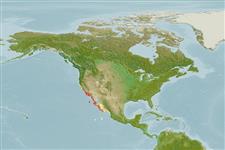Environment: milieu / climate zone / depth range / distribution range
Ecologia
marino demersale; distribuzione batimetrica 0 - 40 m (Ref. 9310). Temperate; 51°N - 14°N, 129°W - 92°W
Eastern Pacific: Vancouver Island in British Columbia, Canada, to Gulf of California; rare north of Point Conception in California, USA.
Size / Peso / Age
Maturity: Lm ? range ? - ? cm
Max length : 48.0 cm TL maschio/sesso non determinato; (Ref. 2850); Età massima riportata: 8 anni (Ref. 72462)
Often occur in rocky areas and in kelp beds. Found from inshore areas to 40 m depth. Feed on seaweed and small invertebrates. Pelagic spawner (Ref. 56049). Also caught with harpoons. The flesh is of excellent quality and is marketed fresh (Ref. 9310).
Life cycle and mating behavior
Maturità | Riproduzione | Deposizione | Uova | Fecundity | Larve
Pelagic spawner (Ref. 56049).
Eschmeyer, W.N., E.S. Herald and H. Hammann, 1983. A field guide to Pacific coast fishes of North America. Boston (MA, USA): Houghton Mifflin Company. xii+336 p. (Ref. 2850)
IUCN Red List Status (Ref. 130435: Version 2024-2)
Threat to humans
Harmless
Human uses
Pesca: pesca di sussistenza
Strumenti
Special reports
Download XML
Fonti Internet
Estimates based on models
Preferred temperature (Ref.
123201): 12.5 - 22.3, mean 18.1 °C (based on 18 cells).
Phylogenetic diversity index (Ref.
82804): PD
50 = 0.7500 [Uniqueness, from 0.5 = low to 2.0 = high].
Bayesian length-weight: a=0.01122 (0.00514 - 0.02450), b=3.04 (2.87 - 3.21), in cm total length, based on all LWR estimates for this body shape (Ref.
93245).
Trophic level (Ref.
69278): 2.7 ±0.22 se; based on food items.
Resilienza (Ref.
120179): Medio, tempo minimo di raddoppiamento della popolazione 1.4 - 4.4 anni (tm=2).
Fishing Vulnerability (Ref.
59153): Moderate vulnerability (38 of 100).
Nutrients (Ref.
124155): Calcium = 43.9 [26.8, 83.1] mg/100g; Iron = 0.404 [0.251, 0.677] mg/100g; Protein = 18.4 [17.5, 19.4] %; Omega3 = 0.511 [0.305, 0.873] g/100g; Selenium = 12.1 [6.2, 23.6] μg/100g; VitaminA = 10.3 [3.1, 34.2] μg/100g; Zinc = 0.653 [0.476, 0.917] mg/100g (wet weight);
